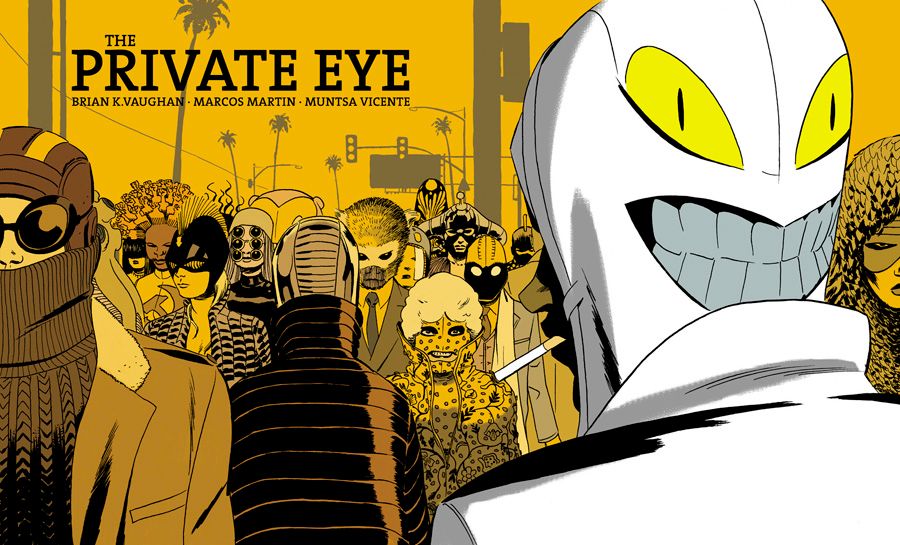Brian K. Vaughan and Marcos Martin are certainly getting attention today for unveiling, out of nowhere, their new digital comic "The Private Eye" #1. Offered up with a "pay what you want" structure, this different approach to making money with digital comics is sure to catch people's interest. Perhaps more importantly, though, once you read it I think you'll be intrigued enough to want to stick around for issues #2-10.
Setting a price tag online to pay what you want isn't a new idea, of course. It gained a lot of prominence in the music world with high-interest items like Radiohead's "In Rainbows" but it's been used in everything from restaurants to theatres. It's also a bit of a gamble; in the FAQ at the Panel Syndicate site where Vaughan and Martin have released their comic, they suggest that 99 cents might be a good price. But of course, there's nothing to stop people from paying less (you can even put in a price tag of zero, although the creators do warn that if everyone did that the chances of "The Private Eye" being concluded would drop significantly), with Vaughan and Martin left with a lot of time and effort expended and nothing to show for it.
That said, "The Private Eye" #1 is a great choice for using pay what you want. It's well written and drawn, and it's got enough of a different setting that it'll stick in readers' heads. "The Private Eye" is set in the future, where the internet has been dismantled and as part of the sequence that led to that decision, everyone is hiding their identities as best as they can. That's where we meet our main character, someone who uses the name "Patrick Immelman" (but whose real name is currently unknown). And as he moves through this world of the future we see what private detectives do in a landscape without the internet; they spy on people to find out who they really are underneath their ubiquitous masks.
Because at its heart, "The Private Eye" is a reimagining of the old pulp detective novel. I like this updating, where everyone wears physical masks (instead of just emotional ones) and the secrets that we keep are what the new brand of paparazzi seek out. Vaughan's creation of this future is fun and intriguing; it uses just the right level of nods to the older story form even while transforming it into something that feels fresh. Our lead character is a bit of an enigma at this point, but that's clearly a deliberate move on the part of Vaughan. After all, we don't know his name (his front door to his office shows the symbol for pi rather than a form of address), and he's masked on most of the pages of the comic as well.
Martin's art is beautiful in "The Private Eye" #1. His lines are fine and tight, and his characters are expressive as they move elegantly across the page. I love all the work that he put into drawing the hundreds of masks that appear in this comic; in a world where everyone wears one, it would have been easy to just default to a few simple forms. Instead we get everything from fish to tiger heads, plus sinister grinning hoodies, domino masks, and Venetian plague masks.
Martin's understanding of how to lay out a page is on display here, too. Look at the first page, where we have Patrick taking photos of an unknowing target. The first two panels follow the lens of the camera up the body as Patrick clicks away, even as the panels themselves move down the page to the third image. It's perfectly in line with the progression of the first two panels, and at a glance it looks to be a third panel as Patrick takes another shot. But as your eye settles on that third image, Martin reveals that it's not another panel; it's the lens of the camera, and part of a greater whole as your eyes slide back to see the body of the camera and Patrick's face and hands behind it. It's that sort of storytelling technique that sets Martin above other artists. On page 3 when Patrick hears a "Hey!" behind him, the panel is positioned in the upper left hand corner of the page, so that the figures behind him in the big image are behind both that tiny panel, as well as where Patrick is kneeling in the second panel. It's a careful attention to detail, understanding that the entire page needs to work together, not just the individual panels.
There are a couple of slightly clunky moments in "The Private Eye" #1, though. The scene with Patrick talking with his father comes across as weak in both story and art, most notably. Vaughan's script has a lot of exposition delivered on those pages, and while I get that it's important to give us this information, it feels extremely inelegant and forced. Martin' art also isn't quite up to snuff here; Patrick's face looks a little distended and misshapen, and the storytelling itself doesn't grab you like it does elsewhere.
Still, a slight stumble aside, "The Private Eye" #1 is an excellent debut from Vaughan and Martin. It's been a few years since the duo worked together on their "Doctor Strange" mini-series, and it's fun to see them reunited on a project that they've built from the ground up. You should absolutely check this out; after all, you can give as much or as little money as you want. Myself? I know I'll be back to buy the second issue. Definitely give this comic a try.

